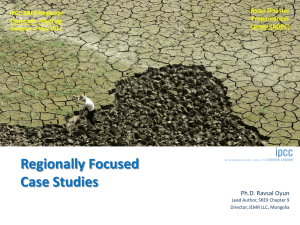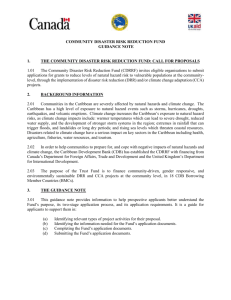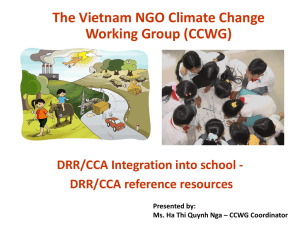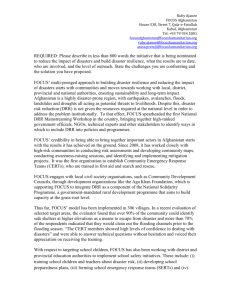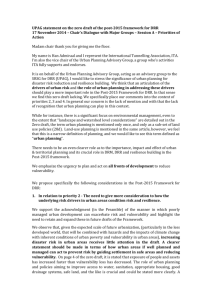Full report
advertisement
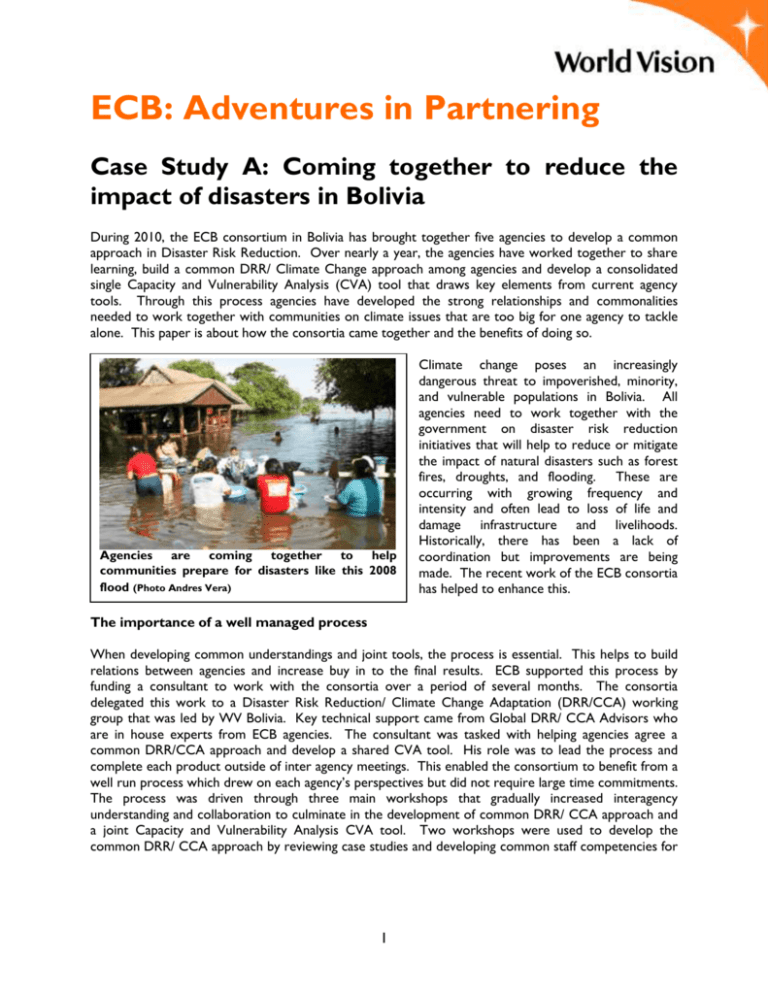
ECB: Adventures in Partnering Case Study A: Coming together to reduce the impact of disasters in Bolivia During 2010, the ECB consortium in Bolivia has brought together five agencies to develop a common approach in Disaster Risk Reduction. Over nearly a year, the agencies have worked together to share learning, build a common DRR/ Climate Change approach among agencies and develop a consolidated single Capacity and Vulnerability Analysis (CVA) tool that draws key elements from current agency tools. Through this process agencies have developed the strong relationships and commonalities needed to work together with communities on climate issues that are too big for one agency to tackle alone. This paper is about how the consortia came together and the benefits of doing so. Agencies are coming together to help communities prepare for disasters like this 2008 flood (Photo Andres Vera) Climate change poses an increasingly dangerous threat to impoverished, minority, and vulnerable populations in Bolivia. All agencies need to work together with the government on disaster risk reduction initiatives that will help to reduce or mitigate the impact of natural disasters such as forest fires, droughts, and flooding. These are occurring with growing frequency and intensity and often lead to loss of life and damage infrastructure and livelihoods. Historically, there has been a lack of coordination but improvements are being made. The recent work of the ECB consortia has helped to enhance this. The importance of a well managed process When developing common understandings and joint tools, the process is essential. This helps to build relations between agencies and increase buy in to the final results. ECB supported this process by funding a consultant to work with the consortia over a period of several months. The consortia delegated this work to a Disaster Risk Reduction/ Climate Change Adaptation (DRR/CCA) working group that was led by WV Bolivia. Key technical support came from Global DRR/ CCA Advisors who are in house experts from ECB agencies. The consultant was tasked with helping agencies agree a common DRR/CCA approach and develop a shared CVA tool. His role was to lead the process and complete each product outside of inter agency meetings. This enabled the consortium to benefit from a well run process which drew on each agency’s perspectives but did not require large time commitments. The process was driven through three main workshops that gradually increased interagency understanding and collaboration to culminate in the development of common DRR/ CCA approach and a joint Capacity and Vulnerability Analysis CVA tool. Two workshops were used to develop the common DRR/ CCA approach by reviewing case studies and developing common staff competencies for 1 DRR1. During the first meeting agencies worked together to agree the parameters for case studies and start drafting common DRR competencies. In between meetings the consultant interviewed key stakeholders and drafted the competencies based on emerging themes. A few months later agency case studies and the final draft competencies were reviewed in depth during the second five day workshop. This culminated in the development of a shared DRR/ CCA approach and common DRR staff competencies. ECB funding for a consultant and the support of two of the agencies global DRR/CCA Advisors ensured that the process was well run, kept momentum and that joint products were being developed between meetings. Finally the third five day workshop, in October 2010, was used to start the consolidation of single agency CVA tools into a common tool. In a few months, agencies had moved through several stages of collaboration from sharing information and learning together, to developing new tools and approaches. To come together to create something new where there are gaps, like the DRR competencies, is a good achievement. However, for agencies to compromise on their existing tools for the common good requires a much deeper level of commitment to collaboration. The depth of this commitment can be seen in the use of common tools and approaches when approaching key donors, such as DIPECHO in Bolivia. When working on collaborative initiatives it was very important to have an appropriate level of well-timed technical assistance (the Global DRR/ CCA Interagency Advisor group), a good broker (the Consultant) and a good process. Developing common tools in the field When agencies talk about coming together to work on joint tools, this is often a negotiation among peers in a national capital, miles away from the field. In Bolivia, the ECB consortium decided to do something different. Rather than sit in a hotel room in a major city to learn about each others tools, key staff from each agency spent two days in the field using each others´ capacity and vulnerability tools with communities. This helped to broaden their understanding of the strengths and short comings of the different approaches. It also provided a common team building experience that strengthened the relationships that are crucial to collaboration. The two days of field work took place in the middle of the October 2010 five day workshop, with the final day taken up with debriefs and action planning around the process to finalise a common capacity and risk tool. This drew on the best parts of CARE’s Climate Vulnerability Capacity Assessment, Oxfam’s Participatory Capacity and Vulnerability Analysis and World Vision’s COVACA tool. From common tools to a common cause ECB agencies work with each other’s tools to develop a single unified approach: Field Testing with Schoolchildren in Oruro Photo: Melisa Bodenhamer Through working together to discuss and develop common approaches to DRR, the Bolivian agencies have laid a good foundation to jointly tackle complex issues. Global tools and approaches have been contextualised so that they are appropriate for the varied local conditions in Bolivia. Having a common approach and CVA tool is being used as the basis for a joint proposal to DIPECHO (World Vision, Plan International and Save the Children). In future, WV Bolivia plans to work with other agencies to advocate with the National Civil Defence Agency to have a common CVA tool nationwide. This will make it easier for communities and government counterparts to work with each of the agencies on the big climate issues that they face. Such an approach is essential because agency areas of operation can 1 The consultant’s work on developing common DRR staff competencies was part of a larger piece of work on Staff Capacity that developed broader staff competencies as well. 2 overlap and the nature of DRR is that many of hazards and risks faced by communities can spill over project and administrative boundaries. For example deforestation is a key issue that increases people vulnerability to floods and other types of disaster. Tackling the root causes of huge problems like these requires agencies to come together with government to tackle the root causes of vulnerability on a local regional and national level. Agencies now have a common approach and the relationships and understandings needed to implement this in the field. To learn more…… “ECB: Adventures in Partnering” is a series of 14 discussion papers and case studies that represent the views and experience of more than 30 World Vision field staff, technical specialists and managers who are involved in the Emergency Capacity Building Project (ECB), a partnership with CARE, Catholic Relief Services, Mercy Corps, Oxfam GB and Save the Children to “improve speed, quality, and effectiveness of the humanitarian community to save lives, improve the welfare, and protect the rights of people in emergency situations.” Papers in the series are: Discussion #1: “Avoiding delegated enthusiasm” Discussion #2: “More than talking; partnering means results” Case study A: “Coming together to reduce the impact of disasters in Bolivia” Case study B: “ Emergency Simulations” Discussion #3: “Does World Vision’s culture of internal complexity make it harder to partner?” Case study C: “Inter-agency response protocols for rapid onset emergencies in Indonesia” Discussion #4: “The dilemma of global initiatives and local implementation” Case study D: “Developing a post – disaster joint advocacy strategy in Bangladesh” Discussion #5: “Collaboration – who pays for it; who should do it?” Case study E: “Translating the Good Enough Guide into Bangla” Discussion #6: “Emergencies & Development – external environments and partnering” Case study F: “Chaos to collaboration – experience with a rapid assessment in Uganda” Discussion #7: “Partnering – hints and tips from practitioners” Discussion #8: “Starting your own collaboration” If you want to know more about the ECB Project visit www.ecbproject.org. For more on World Vision’s involvement in the ECB Project contact Wynn Flaten at wflaten@worldvision.org. Disclaimer: The views expressed in this document are those of the authors and do not necessarily reflect the views or official position of World Vision. 3
